The Manufacturing Institute Goes to Capitol Hill

Manufacturing Institute Executive Director Carolyn Lee testified virtually before the House Committee on Veterans’ Affairs’ Subcommittee on Economic Opportunity yesterday, detailing the MI’s work with transitioning service members during the pandemic. Here are some highlights from her testimony.
COVID-19’s impact: According to Lee, the COVID-19 pandemic made it much more difficult for transitioning service members to access key resources, including training programs, fellowships and internships.
Our work: The MI’s Heroes MAKE America initiative helped develop workarounds for these challenges, Lee testified.
- “At the onset of the pandemic, we collaborated with our education partners to pivot most of our program delivery to virtual platforms or socially distanced environments—within a matter of weeks,” she said. “COVID-19 also accelerated the deployment of fully remote learning for Heroes participants, proving that we can deliver some certifications online.”
- Lee also highlighted the launch of Heroes Connect, which allowed transitioning service members to network virtually with hiring managers from manufacturers across the country.
Heroes’ overall success: The Heroes program has been very successful since its creation only three years ago, Lee noted. “Since its inception in January 2018, Heroes MAKE America has had a placement rate of 92%. Participants have found jobs at more than 250 companies in 39 states.”
- She added, “Notably, 55% of our participants have no post-secondary education, indicating a strong need for support to position them for success in a career after their time in uniform.”
What policymakers can do: Lastly, Lee recommended policy changes that could make military transitions more accessible to service members and their families.
- First, “Congress should change eligibility requirements for Pell grants to allow students to pursue high-quality programs as short as eight weeks.”
- In addition, Lee recommended a separate allocation of funding under the Workforce Innovation and Opportunity Act for the military community. While those funds are currently given directly to states, which place limits on their use, service members may participate in training virtually or in a different location than where they transition. They need the flexibility to receive training or plan careers without worrying about state lines.
The last word: “Veterans are well positioned to succeed in a manufacturing career with skills, talents and training that are highly valued in the industry,” said Lee. “And with more than 700,000 manufacturing jobs open today—and 4 million to fill by 2030—they are in great demand. The Manufacturing Institute is committed to helping today’s American heroes become tomorrow’s manufacturing leaders.”
MLC Honors Manufacturing Leaders
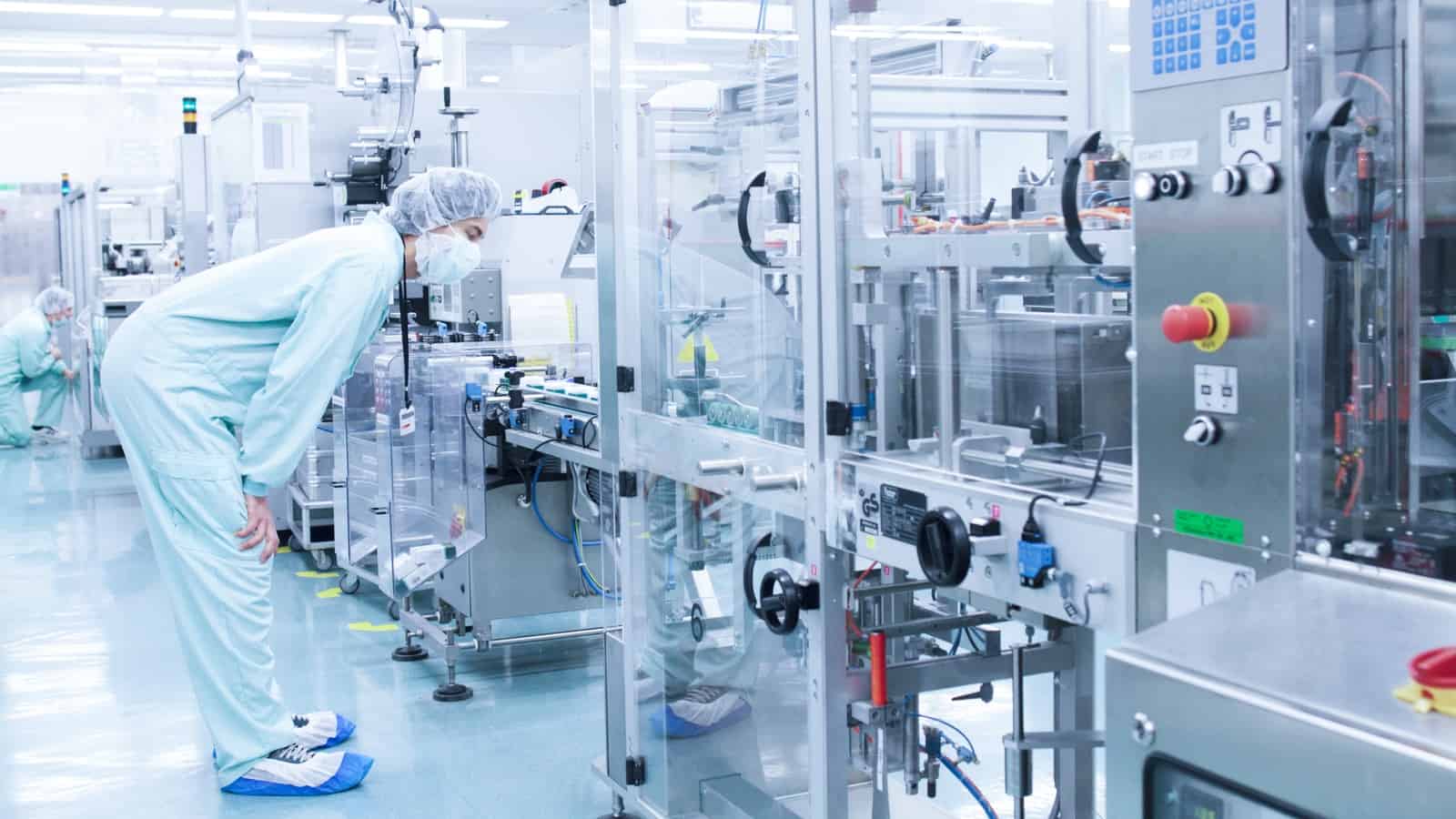
During a year of extraordinary disruptions and challenges, manufacturers stepped up in extraordinary ways. That’s the message of this year’s Manufacturing Leadership Awards, taking place on May 19 and hosted by the NAM’s Manufacturing Leadership Council—a business leadership network dedicated to senior manufacturing executives and aimed at supporting companies through the industry’s digital transformation.
What they are: The Manufacturing Leadership Awards are presented to world-class manufacturing companies and individual leaders in a range of categories, from Artificial Intelligence and Advanced Analytics Leadership to Collaborative Innovation Leadership to Sustainability Leadership. The online gala will recognize exciting and innovative manufacturers who excelled in these areas and will feature a virtual after-party with entertainment for guests.
Among the winners: Here are a few examples of this year’s winning projects.
- A pharmaceutical company partnered with another company to scale up the production of a COVID-19 treatment. As a result of their collaboration, a production transfer that would normally take 12 months was completed in just 123 days.
- An automaker developed a technology center dedicated to making 3D printing a mass-scale production reality for their plants around the world. It is developing new products faster than ever and improving its assembly operations.
- A technology manufacturer implemented AI and edge computing in its inspection process, reducing inspection times from 10 minutes to less than one minute while significantly improving inspection accuracy.
New and of note: One new element of this year’s celebration is the Creators Respond Honor Roll. So many manufacturers went above and beyond in responding to the global pandemic that the MLC decided to recognize their achievements in a separate category.
Still to come: Several honorees won’t be announced publicly until the gala itself, including the High Achievers, Manufacturers of the Year and Manufacturing Leaders of the Year—so be sure to tune in on May 19.
The word from the MLC: “Tested with challenges they never could have imagined, manufacturers rose to the occasion to keep factories open, sometimes with significant changes to their production and supply chains,” said Manufacturing Leadership Council Co-Founder, Executive Director and Vice President David R. Brousell. “At the same time, manufacturers doubled down on digital transformation as they sought greater agility and flexibility in their businesses. These awards honor the innovation and resolve that manufacturers demonstrate at all times, and especially in times of crisis.”
You can RSVP for the event here.
2.1 Million Manufacturing Jobs Could Go Unfilled by 2030
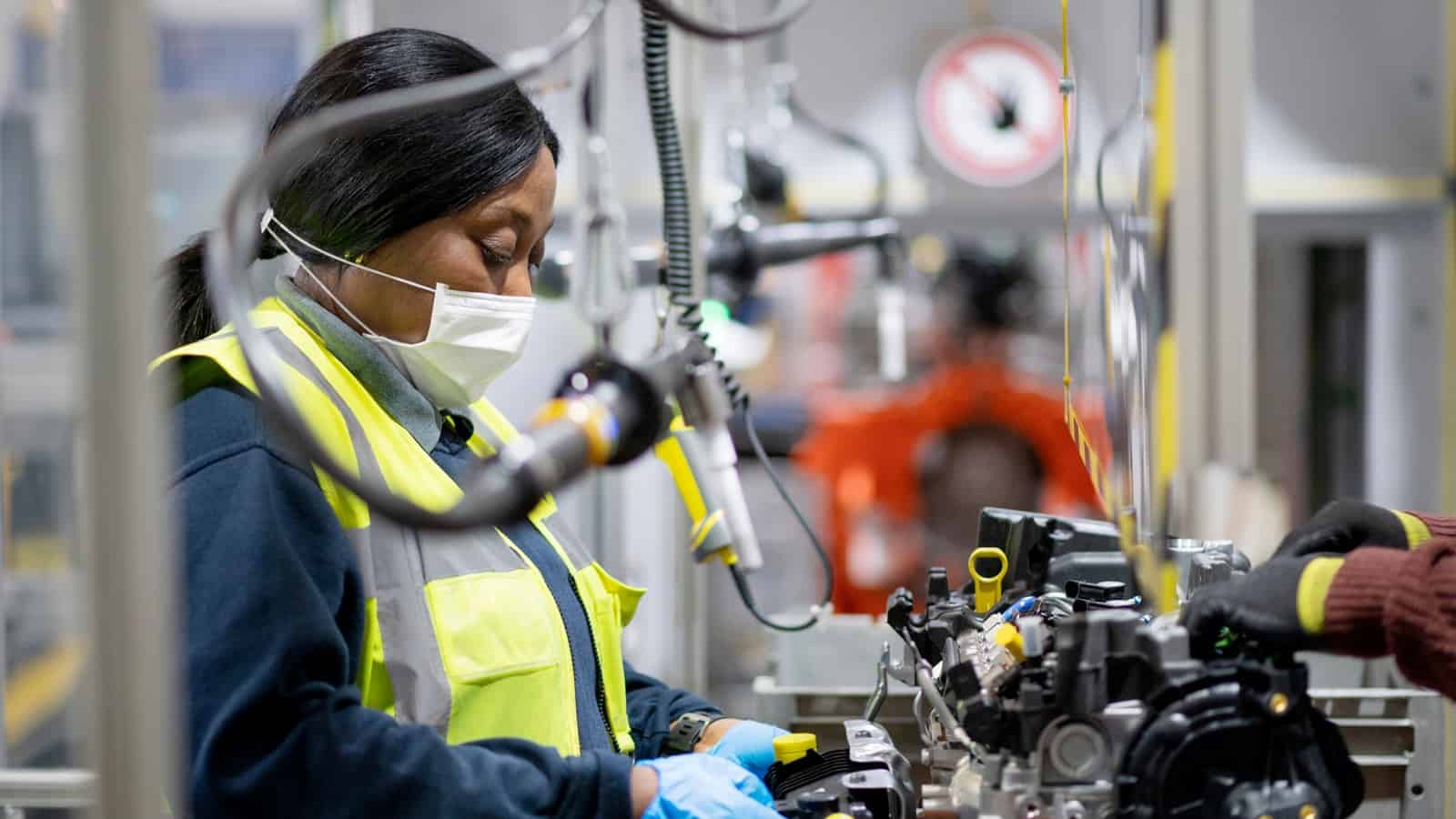
The manufacturing skills gap in the U.S. could result in 2.1 million unfilled jobs by 2030, according to a new study by Deloitte and The Manufacturing Institute, the workforce development and education partner of the NAM. The cost of those missing jobs could potentially total $1 trillion in 2030 alone.
The study’s dramatic findings come from online surveys of more than 800 U.S.-based manufacturing leaders, as well as interviews with executives across the industry and economic analyses. All told, they paint a worrying picture of manufacturing’s labor shortage. The lack of skilled labor was the industry’s major challenge even before the pandemic, according to the NAM’s quarterly outlook surveys—and this new study shows it’s still a major concern today.
The hard data: About 1.4 million U.S. manufacturing jobs were lost during the early days of the pandemic, according to the study, setting back the manufacturing labor force by more than a decade. However, the industry has largely recovered those lost jobs and is now urgently seeking more workers.
- While the manufacturing industry recouped 63% of jobs lost during the pandemic, the remaining 570,000 had not been added back by the end of 2020, despite a near record number of job openings in the sector.
The inside scoop: Manufacturers surveyed reported that finding the right talent is now 36% harder than it was in 2018, even though the unemployment rate has nearly doubled the supply of available workers.
- Executives reported they cannot even fill higher paying entry-level production positions, let alone find and retain skilled workers for specialized roles.
- A long-term challenge: 77% of manufacturers say they will have ongoing difficulties in attracting and retaining workers in 2021 and beyond.
A bright spot: Fortunately, the study found that diversity, equity and inclusion (DEI) initiatives exert a growing influence on workforce trends and can help manufacturers fill these empty jobs. Manufacturers have more work to do to attract larger numbers of women and diverse workers to the industry, and the Institute is leading an industry-wide effort to close the opportunity gap.
Deloitte says: “Given the foundational role the manufacturing sector plays in our nation’s economy, it is deeply concerning that at a time when jobs are in such high demand nationwide, the number of vacant entry-level manufacturing positions continues to grow,” said Paul Wellener, Deloitte vice chairman and U.S. industrial products and construction leader. “Attracting and retaining diverse talent presents both a challenge and solution to bridging the talent gap. To attract a new generation of workers, the industry should work together to change the perception of work in manufacturing and expand and diversify its talent pipeline.”
The Institute says: “Manufacturers are proud to lead efforts to build stronger, more diverse and inclusive workplaces because we are committed to being the solution,” said Carolyn Lee, executive director of the Institute. “As we expand our programs at The Manufacturing Institute, and work with the National Association of Manufacturers on initiatives like our Creators Wanted campaign and tour, we’re making sure that Americans of all backgrounds in all states can find a home in manufacturing and get equipped with the skills to seize these opportunities.”
Manufacturing Institute Takes on Second Chance Hiring
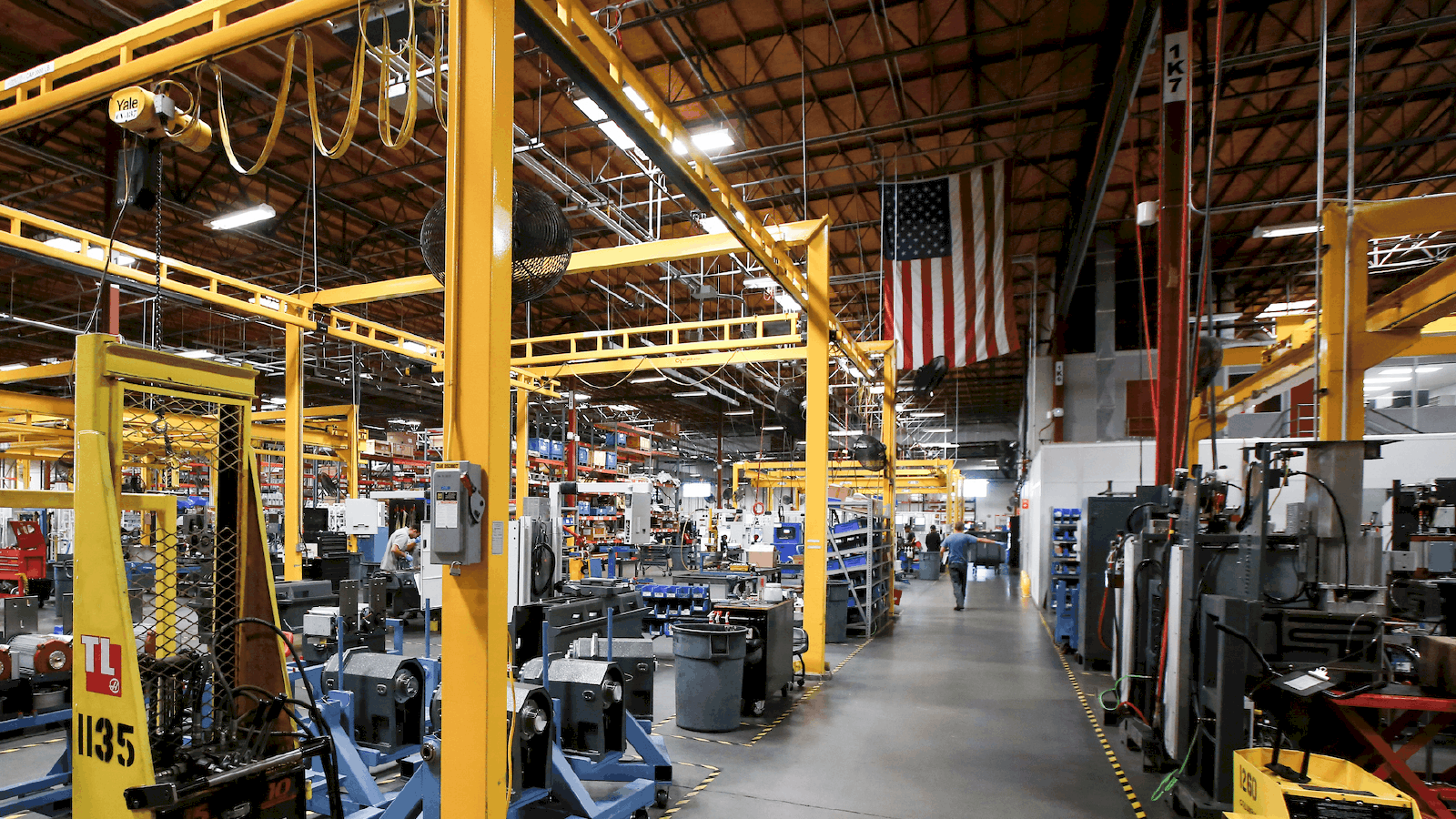
The Manufacturing Institute—the workforce development and education partner of the NAM—is partnering with the Charles Koch Institute to expand second chance hiring opportunities in the manufacturing industry.
What is second chance hiring? One in three Americans possess a criminal record. Without being offered a “second chance” at a stable job, many in this sizable talent pool are excluded from the workforce.
Why it matters: The manufacturing industry has more than half a million jobs open right now and will need to fill 4 million over the next decade. Second chance programs not only increase equal opportunity and diversity in the industry but are also a key tool for building manufacturing’s future workforce.
What we’re doing about it: The MI’s initiative, funded by a grant from the Charles Koch Institute, will offer resources and expertise to help employers make the best use of second chance hiring. These resources will include roundtable discussions and webinars, C-suite leadership events, case studies, a pilot program and original research for the manufacturing industry.
The MI says: “Second chance hiring gives businesses an opportunity to welcome highly motivated, engaged, productive and loyal new team members that may otherwise be overlooked,” said MI Executive Director Carolyn Lee. “This is not only the right thing to do for our businesses, but it’s also the right thing to strengthen our communities.”
- “This partnership enables the MI to educate manufacturers in America on second chance hiring best practices and help them utilize second chance hiring as a strategy to fill open jobs. This effort will also expand our Diversity and Inclusion initiative that’s critical to the future health and success of the industry.”
A real-world example: Nehemiah Manufacturing Co., a consumer-product manufacturer in Cincinnati, has a workforce of about 180 employees—about 80% of whom have criminal records, according to The Wall Street Journal (subscription). These employees serve in all sorts of positions, including leadership roles, from production to fulfillment and more.
- “We found that the population we were hiring who had criminal backgrounds were our most loyal people,” Nehemiah President Richard Palmer told the Journal. “When we were looking for people to work overtime, come in on Saturday or go that extra mile, it was the second-chance population that was saying, ‘I’m in.’”
The last word: “One of the biggest barriers to successful reentry for those with a record is lack of employment opportunities,” said CKI Executive Director Derek Johnson. “If we truly want to reduce recidivism and increase public safety, all while empowering those returning to our communities to contribute at their fullest potential, we need to expand second chance hiring opportunities. CKI is proud to join this partnership to scale that impact and expand second chance hiring across more employers.”
Consequences of a Higher Corporate Tax Rate: 1 Million Jobs Lost in First Two Years
Timmons: “America can’t afford that, especially now.”
Washington, D.C. – The National Association of Manufacturers released a new study detailing the short- and long-term damage to the American economy under tax proposals to increase the corporate tax rate and repeal policies that made manufacturing in America more competitive around the world.
“Manufacturers want to help President Biden achieve his goal of creating jobs in America and strengthening the supply chain so that our country does not face critical shortages, especially during times of national crises.
“As we slowly emerge from the economic catastrophe caused by COVID-19, American businesses are at a pivotal point in our nation’s history. Manufacturers can, and should, lead the economic recovery in the wake of the pandemic. But this study tells us quantitatively what manufacturers from coast to coast will tell you qualitatively: increasing the tax burden on companies in America means fewer American jobs. One million jobs would be lost in the first two years, to be exact,” said NAM President and CEO Jay Timmons.
“After decades of advocating for a tax system that provided competitive rates and modern international tax provisions, manufacturers in America kept our promises following the enactment of the 2017 tax reforms: we raised wages and benefits, we hired more American workers, and we invested in our communities. If we undo those reforms, all of that will be put at significant risk. Manufacturing workers will lose out on jobs, growth and raises. We should be building on that progress, not rolling it back. But the conclusion of this study is inescapable—follow through with tax hikes that give other countries a clear advantage and we’ll see far fewer jobs created in America.”
The study calculated the effects of increasing the corporate tax rate to 28%, increasing the top marginal tax rate, repealing the 20% pass-through deduction, eliminating certain expensing provisions and more. The negative consequences would include the following:
- One million jobs lost in the first two years;
- By 2023, GDP would be down by $117 billion, by $190 billion in 2026 and by $119 billion in 2031;
- Ordinary capital, or investments in equipment and structures, would be $80 billion less in 2023 and $83 billion and $66 billion less in 2026 and 2031, respectively;
- And more.
“There are some who are well-meaning and have suggested that the U.S. corporate tax rate should increase, but not by as much as the 28% proposed. Unfortunately, what that means is that America will still lose jobs and investment, just not quite as much. America just can’t afford that, especially now,” Timmons said.
Click here for a summary of the study’s details and findings. Read the full study, “Dynamic Estimates of the Macroeconomic Effects of Tax Rate Increases and Other Tax Policy Changes,” conducted by Rice University economists John W. Diamond and George R. Zodrow,” here
Background on manufacturing growth following the enactment of tax reform in 2017:
- In 2018, manufacturers added 263,000 new jobs. That was the best year for job creation in manufacturing in 21 years.
- In 2018, manufacturing wages increased 3% and continued going up—by 2.8% in 2019 and by 3% in 2020. Those were the fastest rates of annual growth since 2003.
- Manufacturing capital spending grew by 4.5% and 5.7% in 2018 and 2019, respectively.
- Overall, manufacturing production grew 2.7% in 2018, with December 2018 being the best month for manufacturing output since May 2008.
Manufacturers strongly support President Biden’s focus on bold infrastructure investment, which can be achieved through a combination of revenue sources like those identified in the NAM’s ‘Building to Win.’
-NAM-
The National Association of Manufacturers is the largest manufacturing association in the United States, representing small and large manufacturers in every industrial sector and in all 50 states. Manufacturing employs more than 12.3 million men and women, contributes $2.32 trillion to the U.S. economy annually and has the largest economic multiplier of any major sector and accounts for 63% of private-sector research and development. The NAM is the powerful voice of the manufacturing community and the leading advocate for a policy agenda that helps manufacturers compete in the global economy and create jobs across the United States. For more information about the NAM or to follow us on Twitter and Facebook, please visit www.nam.org
Manufacturers: Build Now for the Post-Pandemic World
When manufacturing is strong, America is strong
Washington, D.C. – National Association of Manufacturers President and CEO Jay Timmons released the following statement on President Joe Biden’s infrastructure framework.
“The President’s proposal for historic levels of infrastructure investment reflects many of the investment priorities in the NAM’s ‘Building to Win’ plan, and we look forward to reviewing the details. President Biden’s clear focus on strengthening manufacturing and the workforce of the future shows that he is truly committed to building the next post-pandemic world—one that is stronger and more resilient than in pre-pandemic times.
“Manufacturers have played a leading role in the fight against COVID-19, and we will continue to play a leading role in our economic recovery. When manufacturing is strong, America is strong.
“One thing is clear for our industry, though. Raising taxes on manufacturers would fundamentally undermine our ability to lead this recovery. Our industry fought for decades to achieve a tax system that includes competitive rates and modern international tax provisions. As a result of the 2017 reforms, manufacturers kept our promises: we raised wages and benefits, we hired American workers, and we invested in our communities. Raising taxes on manufacturers here at home would jeopardize all of that and make it more difficult for them to compete in the global economy—putting investment, jobs and livelihoods at risk. We believe strongly in bold infrastructure investment, and we know it can be achieved through a combination of revenue sources like those we identified in the NAM’s ‘Building to Win,’ which includes user fees and bond financing for capital projects. We also know that making the men and women who make things in America pay for the infrastructure projects that will benefit all Americans just doesn’t make sense and would harm their future. Let’s keep moving forward and not turn back the clock to the archaic tax policies that gave other countries an advantage over America.
“To be sure, President Biden’s proposal on infrastructure investment is strong, necessary and welcome. Achieving our shared goals will be the result of debate, discussion and collaboration with the administration and both parties in Congress. We can achieve the President’s investment objectives while holding firm against financing proposals that would severely harm the ability of manufacturers to invest and hire workers here in the U.S. We look forward to engaging with all stakeholders to achieve an outcome that benefits all economic sectors and all Americans.”
Background on manufacturing growth following the enactment of tax reform in 2017:
- In 2018, manufacturers added 263,000 new jobs. That was the best year for job creation in manufacturing in 21 years.
- In 2018, manufacturing wages increased 3% and continued going up—by 2.8% in 2019 and by 3% in 2020. Those were the fastest rates of annual growth since 2003.
- Manufacturing capital spending grew by 4.5% and 5.7% in 2018 and 2019, respectively.
- Overall, manufacturing production grew 2.7% in 2018, with December 2018 being the best month for manufacturing output since May 2008.
-NAM-
The National Association of Manufacturers is the largest manufacturing association in the United States, representing small and large manufacturers in every industrial sector and in all 50 states. Manufacturing employs more than 12.3 million men and women, contributes $2.32 trillion to the U.S. economy annually and has the largest economic multiplier of any major sector and accounts for 63% of private-sector research and development. The NAM is the powerful voice of the manufacturing community and the leading advocate for a policy agenda that helps manufacturers compete in the global economy and create jobs across the United States. For more information about the NAM or to follow us on Twitter and Facebook, please visit www.nam.org.
Why a Navy Machinist Chose a Manufacturing Career
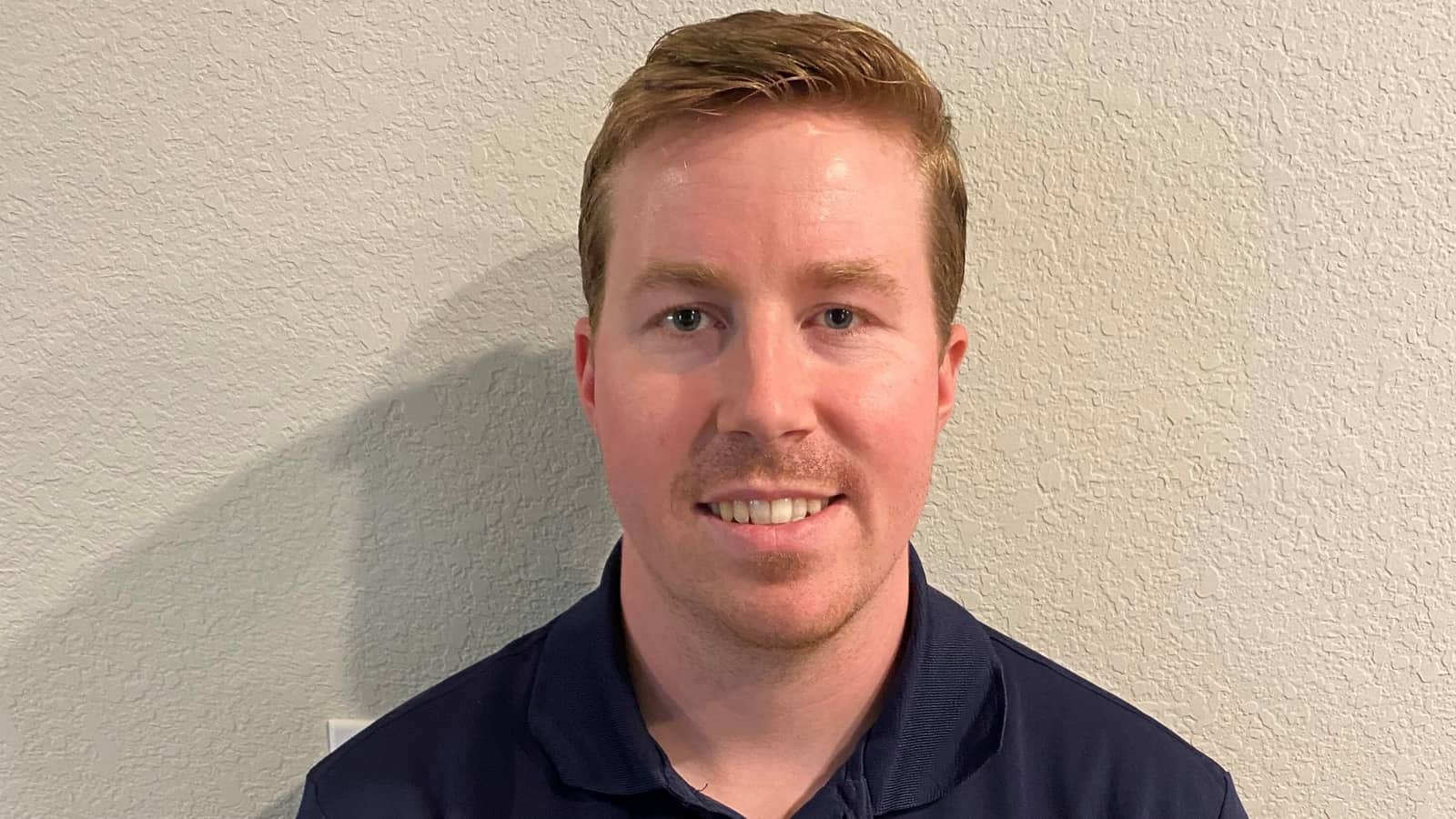
Derek Read always knew he wanted to join the Navy, and he enlisted after high school—rising to become a machinist’s mate responsible for maintaining, repairing and running the ship’s engine as well as corresponding machines and equipment. However, when it came time to find his next career nine years later, he wasn’t sure what to do—until his research turned up the The Manufacturing Institute’s Heroes MAKE America program, which helped Read translate the skills he already had into a modern manufacturing setting.
- “It’s definitely been enlightening,” said Read. “For the most part, I had the mechanical background and most of the skills, but HMA bridged the gap and gave me some technical expertise, as well as the extensive knowledge and certifications needed to get hired by a manufacturing company. Overall, it’s been an amazingly positive experience.”
One-on-one: Some of Read’s most valuable experiences were his meetings with executives and hiring officers at different manufacturing companies.
- “One of the greatest things they’ve given us is facetime with manufacturing company VPs, HR representatives and recruiters,” said Read. “They allowed us to get a better understanding of what was out there and what companies were looking for. Facetime like that is hard to come by unless you’re doing a specialized program like this, and it’s worth a lot.”
What’s next: Today, Read is fielding a few different job interviews, which he received via LinkedIn after Heroes helped him create his profile on the site. “Without HMA, I probably wouldn’t have been approached by those companies,” said Read.
Paying it forward: When asked what advice he’d give to other transitioning servicemembers considering the Heroes program, Read didn’t hesitate. “That’s easy—you’d be crazy not to take advantage of an amazing opportunity like this,” said Read. “The HMA program is outstanding. Take advantage of programs like this one, and don’t wait. Different manufacturing companies have a vast array of jobs. There’s definitely a job out there for you.”
From a distance: What makes Read’s enthusiasm all the more compelling is that he experienced the entire program remotely. But with the help of some virtual reality tools, he was able to participate without missing a step.
- “The VR goggles—that was amazing,” said Read. “I’ve never played with VR before. It’s almost like a video game. The training and tool seminars—I got to play with different tools and interact with the VR, doing measurements, calibrating equipment and going over parts of the manufacturing facility. It was a lot of fun to play with.”
That kind of substantive learning in an engaging environment is what the Caterpillar Foundation will bring to more heroes in the coming years, thanks to its new $2.25 million donation designed to help Heroes MAKE America increase its integration of virtual reality technology and expand training opportunities for the military community.
The last word: As Caterpillar Chairman and CEO Jim Umpleby said when the partnership was announced, “Caterpillar is proud of the support provided to veterans and their families through the Caterpillar Foundation’s donation to the Heroes MAKE America program. I am pleased the Foundation can help make this world-class skills training program available to all members of the global military community and connect them to careers in manufacturing.”
A Hero Gets a Shot at Manufacturing
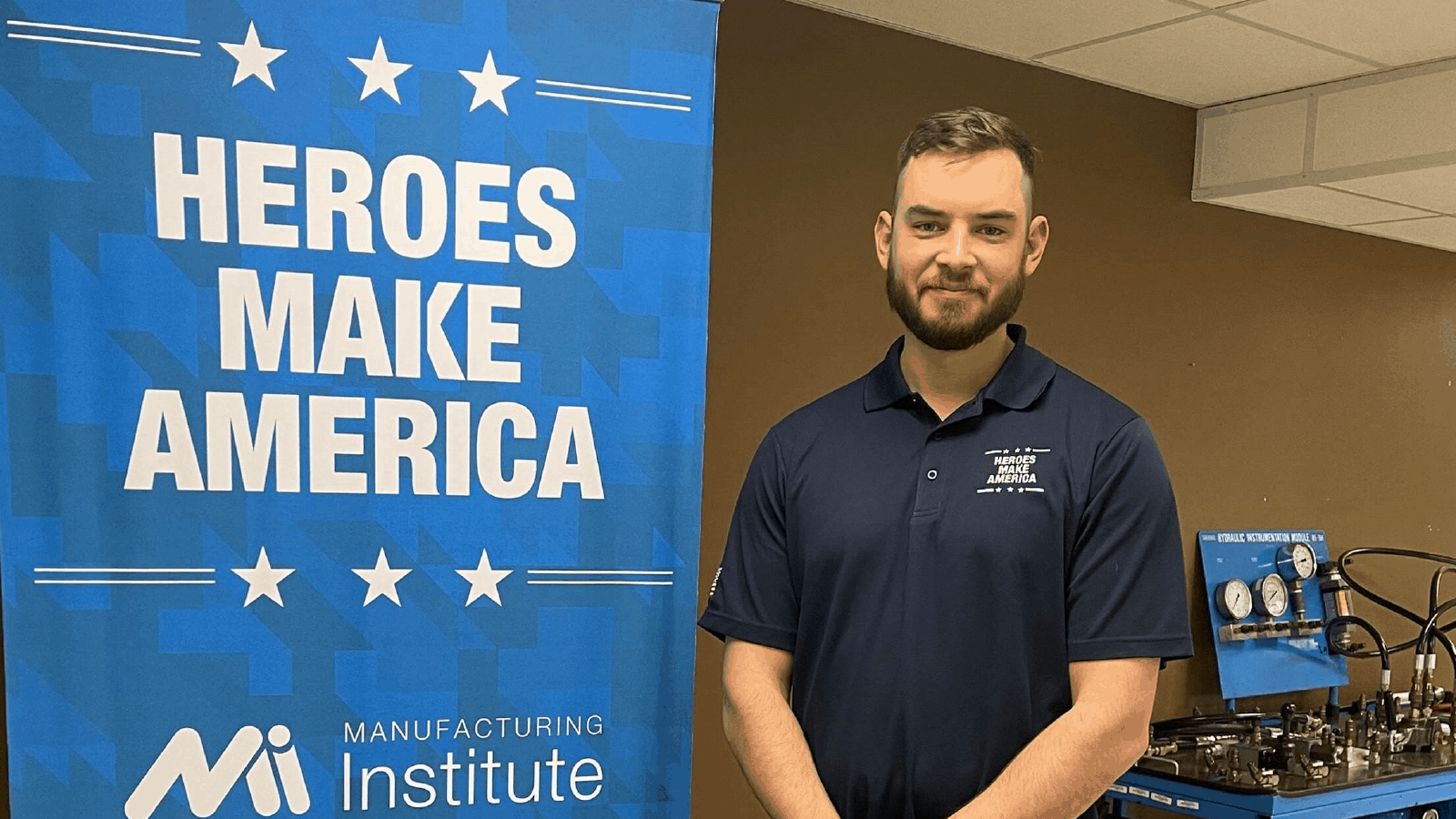
Zachary Willis has transitioned out of the military twice—and the second time, The Manufacturing Institute’s Heroes MAKE America program made all the difference.
A passion for service: Willis had wanted to join the Marine Corps his entire life and felt even more strongly about it after 9/11. A little less than a year after he graduated high school, he did so. “I wanted to serve my country, and my country needed me,” he told us.
Two exits: Willis spent four years in the Marine Corps on active duty, with two deployments as an infantryman. He spent the next four years in the reserves, then left the military for a short stint in the civilian world. But feeling adrift, he ended up joining the U.S. Army as a mechanic in 2017.
When health issues led him to transition out of the military a second time, he knew he needed a strategy for what would come next. The Heroes MAKE America program, which helps members of the military community find opportunities in manufacturing, sounded like a great fit.
- “Getting out this time around was so different from the first time,” said Willis. “The first time I didn’t really have a plan. This time I was a lot more mature. I was like, I need to make sure there is something out there—and Heroes MAKE America seemed like a great opportunity to get into an industry with a lot of growth potential.”
A different world: Heroes exposed Willis to a world of modern manufacturing that was well beyond what he had expected.
- “I always thought manufacturing was just a bunch of guys on an assembly line who put things together for 30 years and then retired,” said Willis. “But then I got into this program, and I saw how innovative it is. It’s constantly seeking improvement. It’s so different from the manufacturing of my father’s or grandfather’s generation.”
An expanded network: Willis is enthusiastic about his experience in the Heroes program—both in terms of the skills training and the opportunities to explore career options.
- “It’s been amazing,” said Willis. “The ability to reach out and connect with other employers all around the country—from smaller companies to huge international corporations. You don’t see that in very many places. I wish more people took advantage of programs like this.”
What’s next: Willis graduated from the program in early March and received four different job offers. He’ll start a new role soon manufacturing gunpowder at Hodgdon Powder Company near his home in Kansas. In fact, he’s so enthusiastic about the Heroes MAKE America program that he’s already encouraging his new employer to get involved.
- “The company isn’t even a part of the program, and when I told them about it, they said, huh, we gotta look into that,” said Willis. “It’s something more companies should get on board with.”
Heroes gets a boost: Willis also got to take on a new challenge during his program: using virtual reality technology to supplement his instructor-led hands-on learning. The technology let him learn everything from how to put on personal protective equipment correctly in a manufacturing environment to how to use welders, micrometers and digital calipers.
And as it happens, even more Heroes students will be able to engage virtually in the coming years. Thanks to a new $2.25 million donation from the Caterpillar Foundation, the Heroes program will be able to increase its integration of virtual reality technology and expand training opportunities for the military community.
The last word: “Caterpillar is proud of the support provided to veterans and their families through the Caterpillar Foundation’s donation to the Heroes MAKE America program,” said Caterpillar Chairman and CEO Jim Umpleby. “I am pleased the Foundation can help make this world-class skills training program available to all members of the global military community and connect them to careers in manufacturing.”
Washington, D.C. – The National Association of Manufacturers released its first Manufacturers’ Outlook Survey of 2021 and the first since the Biden administration took office. The survey showed manufacturers’ optimism increasing to nearly 88%—the highest reading in two years, and up from 74% in the Q4 2020 survey. This steady improvement represents an increase of 54 percentage points since the results of the first survey that measured manufacturers’ sentiment after the pandemic was declared (34% in Q2 2020).
“As vaccines roll out at a faster pace and we see signs of an improving economy, manufacturers’ optimism is rising fast,” said NAM President and CEO Jay Timmons. “Our industry is creating new jobs and investing in new projects, buoyed by signs that we may finally be getting COVID-19 under control. Of course, our industry knows we are not out of the woods yet. That’s why we continue to lead by example, wearing face coverings and promoting vaccination. The smart health protocols are more important than ever. This is our shot—not just to end the pandemic but to build a new and stronger economy that creates opportunity for all.”
Key survey findings include the following:
- In the first quarter, nearly 88% of manufacturers said they were either somewhat or very positive about the outlook for their company.
- Increased costs of raw materials (76%) and the inability to attract and retain talent (66%) were the top-two biggest challenges facing manufacturers in 2021.
- Other top worries included rising health care and insurance costs (50.9%), transportation and logistics costs (50.2%), supply chain challenges with inventory management (48.7%) and an unfavorable business climate, including taxes and regulations (44.0%).
Read the full Q1 2021 Manufacturers’ Outlook Survey results here.
-NAM-
The National Association of Manufacturers is the largest manufacturing association in the United States, representing small and large manufacturers in every industrial sector and in all 50 states. Manufacturing employs more than 12.3 million men and women, contributes $2.32 trillion to the U.S. economy annually and has the largest economic multiplier of any major sector and accounts for 63% of private-sector research and development. The NAM is the powerful voice of the manufacturing community and the leading advocate for a policy agenda that helps manufacturers compete in the global economy and create jobs across the United States. For more information about the NAM or to follow us on Twitter and Facebook, please visit www.nam.org.
Diversity and Inclusion: What You Need to Know
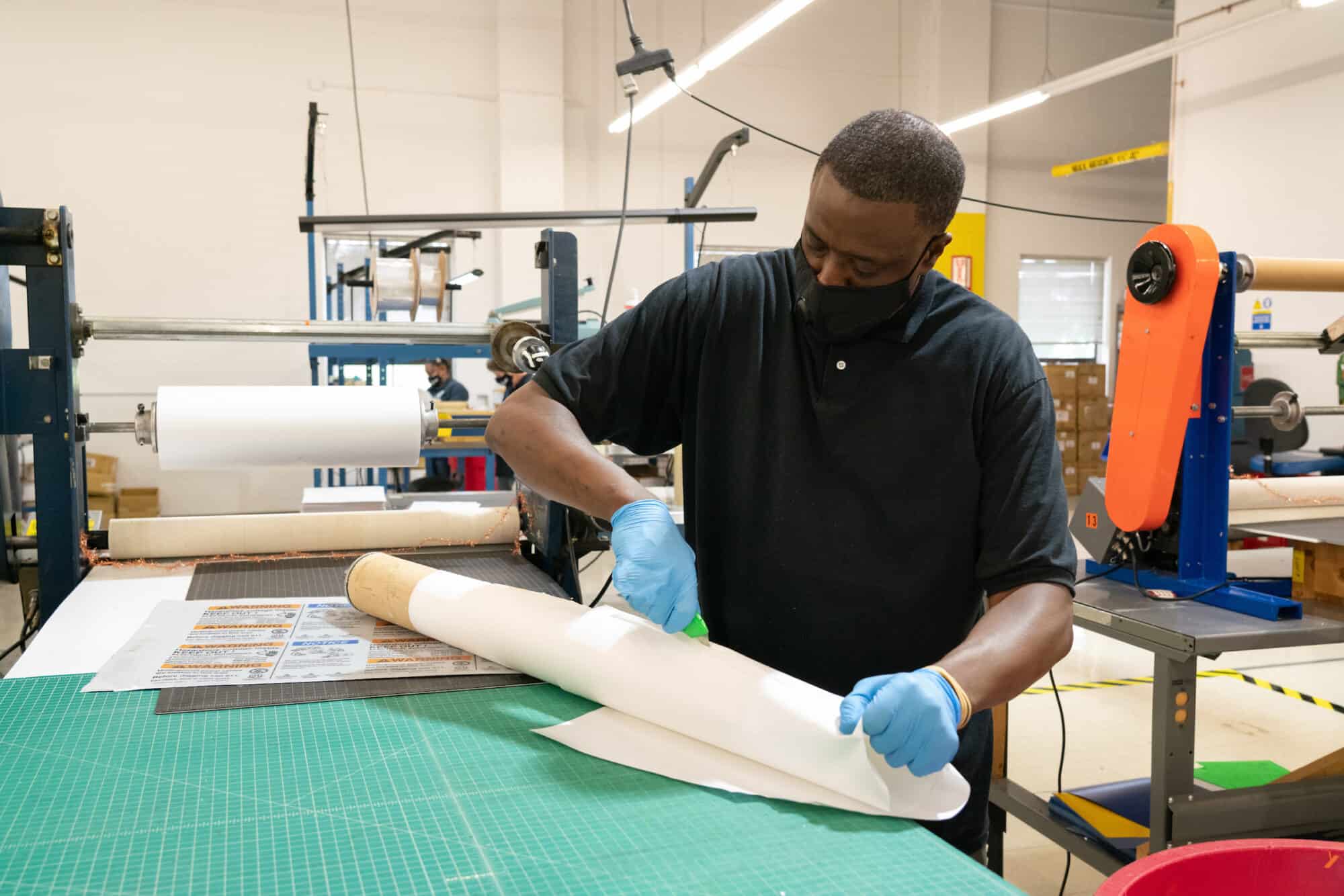
If you’re a manufacturer looking to begin—or improve—your diversity and inclusion efforts, you’ll need some expert advice. That’s why The Manufacturing Institute—the workforce development and education partner of the National Association of Manufacturers—hosted a virtual summit recently on D&I development, drawing together a variety of experts in one comprehensive event. Now you can watch the event online, and to get you started, we’ll give you a quick overview.
Why it matters: Manufacturing workers are deeply diverse in all sorts of ways: age, gender, race and ethnicity, ability and sexual orientation—not to mention education, life experience and socioeconomic background. To be competitive, businesses must be able to connect with the skills and experiences of a wide range of communities.
The main events: The first day of the summit was broken down into several “dimensions” of D&I, each with its own panel of experts:
- Race Dimension: Representatives from HBCU Connect, Pfizer and Ingredion discussed how leaders can promote racial equity in their companies and communities—including by setting measurable hiring goals and increasing internal candidate development.
- Ability Dimension: Panelists from Autism Speaks, Stanley Black & Decker and Lee Container Corporation discussed their work with manufacturers to create 1 million employment and leadership opportunities by 2025 for people with autism and intellectual and/or developmental differences. The panelists highlighted data showing how neuro-diverse individuals strengthen the workforce overall.
- Sexual Orientation Dimension: Representatives of Out Leadership and Dow spoke about how manufacturers can stand up for LGBT+ equality and D&I overall. They recommended supporting LGBT+ equality by being vocal allies and signing on to court cases that protect LGBT+ rights. They also talked about why bringing your whole self to the workplace is critical.
- Military Dimension: Panelists from the MI, Fender Musical Instruments Corporation and Johnson & Johnson discussed how manufacturers can connect directly to transitioning service members, veterans, the National Guard, reservists and active-duty military spouses, including through programs like the MI’s Heroes MAKE America—an integrated training, certification and career-readiness initiative.
- Gender Dimension: Panelists from the MI, Fresenius Medical Care North America and BASF Corporation discussed the steps companies can take to support women in manufacturing—such as creating supportive women-led networks within their businesses and ensuring uniforms are available in female sizes. They also noted the critical progress made so far by programs like the MI’s STEP Women’s Initiative and through local employee resource groups.
- Age Dimension: With one-quarter of the manufacturing workforce over 55 years old, manufacturers must adapt to the needs of older workers. Panelists from AARP, ALOM and Winton Machine Company discussed the importance of two-way learning and how creating mentor–mentee relationships between younger and older employees can build a stronger workforce.
And that’s not all. . . Day Two featured an executive panel titled “Voices from Leadership,” with leaders from the MI, Arconic, Intel Corporation and Deloitte. It also included a goals-oriented panel called “Building D&I Into Team and Individual Goals,” featuring speakers from the MI, BP America, Trane Technologies and Covestro, which focused on how to put this work into practice.
The last word: “We need to close the racial inequities and the gaps that we have in our society because it is the right thing to do, but it is also the economic imperative for our sector,” said MI Executive Director Carolyn Lee. “We need more people—and the workforce of the future is going to look different than the workforce of today.”
